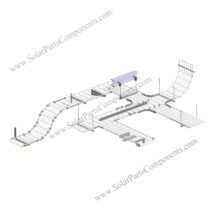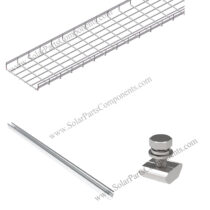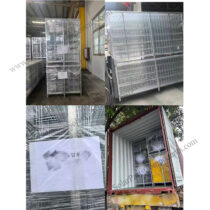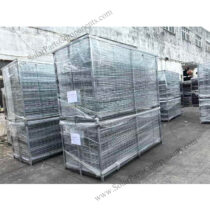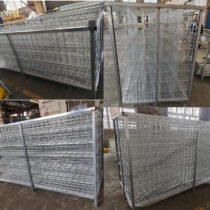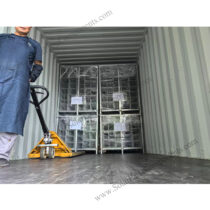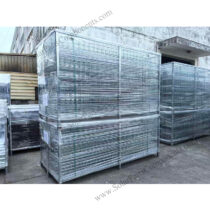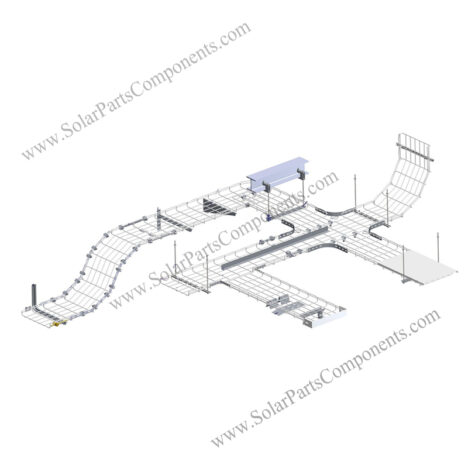
Wire mesh Cable Tray
Product Type: cable tray
Material: HDG steel
Max Wind Load : 60 m/s
Max Snow Load : 3.4 KN / M 2
Length: 2000mm.3000-6000mm or Customization
Width:50-600mm
Height:50-150mm
Introduction
Advavntages:
What is a Wire Mesh Cable Tray?
A wire mesh cable tray, as the name implies, is a type of cable management system primarily constructed from a metal wire mesh. This metal wire is typically made of steel, stainless steel, or aluminum. The wire is woven or welded together to form a grid – like structure. The open – mesh design is its most distinctive feature, which sets it apart from other types of cable trays such as solid – bottom tray cable trays or enclosed trough cable trays.
The wire mesh structure consists of horizontal wires that run along the length of the tray and vertical wires that intersect them at regular intervals. This creates a series of small openings or cells within the tray. The size of these openings can vary depending on the specific application and the size of the cables that the tray is intended to carry. For example, in applications where smaller – diameter cables are used, the openings in the wire mesh can be relatively small, providing a more secure hold for the cables. In contrast, for larger – diameter cables or in situations where there is a need for more ventilation and easier cable access, the openings may be larger.
The edges of the wire mesh cable tray are usually reinforced with additional wire or a metal frame. This reinforcement helps to increase the structural integrity of the tray, ensuring that it can support the weight of the cables without sagging or deforming. The tray may also have mounting points or brackets attached to its sides or bottom, which are used to secure the tray to walls, ceilings, or other support structures. These mounting points are designed to be compatible with a variety of fastening methods, such as bolts, screws, or clips, making the installation process flexible and adaptable to different installation environments.
| Brief Descriptions: | |
| Solar Mounting Components –Wire mesh Cable Tray | |
| Item type: | Wire mesh Cable Tray |
| Type: | |
| Installation Site: | |
| Profile Material: | HDG steel |
| Fasten Parts | Clamp / Screw / Bolts |
| PV Modules: | |
| Module Orientation: | |
| Standards: | AS/NZS 1170 |
| DIN 1055 | |
| GB50009-2012 | |
| IBC2009 | |
| TUV | |
| JIS C 8955: 2011 | |
| International Building Code IBC 2009 | |
| California Building Code CBC 2010 | |
| Warranty | 10 years |
| Designed Lifespan | 25 years |
| Packing Details: | |
| Inner: | Winding film |
| Outer: | Steel Pallet, etc |
Wire mesh cable trays components
Fasteners and Connectors for wire mesh cable tray
Fasteners and connectors are essential components for assembling and installing wire mesh cable tray. Bolts, nuts, screws, and clips are commonly used fasteners. They are used to join different sections of the tray together, attach end fittings, and secure the tray to the support structures. Connectors, such as couplings, elbows, and tees, are used to change the direction of the cable tray, create branches in the cable routing, or connect different lengths of trays. These connectors are designed to provide a strong and reliable connection while still allowing for flexibility in the cable tray layout.
The combination of these components results in a wire mesh cable tray system that is not only highly functional but also adaptable to a wide variety of installation requirements. Whether it’s a simple, straight – run installation in a small office or a complex, multi – level installation in a large industrial facility, the modular nature of the wire mesh cable tray components allows for easy customization and installation.
Applications
Unique Advantages of Wire Mesh Cable Tray in Solar Mounting Systems
Solar mounting systems operate in outdoor, often harsh environments—exposed to sunlight, temperature fluctuations, and occasional weather extremes—while requiring organized, reliable cable management for PV panels, inverters, and monitoring devices. Wire mesh cable tray stands out in this scenario, offering three key advantages tailored to solar projects:
- Exceptional Heat Dissipation Performance
- Superior Wiring Flexibility
- Convenient Installation and Maintenance
- Lightweight design
- Easy accessibility
Installation&Advantages
Installation Methods
- Overhead Suspension
- Wall – Mounted Installation
- Floor – Mounted Installation
Advantages
- High Strength and Lightweight
- Corrosion Resistance
- Fire and High – Temperature Resistance
- Modular Design
- Cost – Effectiveness
- Environmental Friendliness
Conclusion
Wire mesh cable trays have emerged as a highly efficient and versatile solution for cable management across a diverse range of industries. Their open – mesh design, combined with the use of high – quality materials such as steel, stainless steel, aluminum, and FRP, offers a unique set of advantages. These include excellent heat dissipation, easy cable access for maintenance and modifications, high strength – to – weight ratio, corrosion resistance, and modularity for flexible installation.
From industrial factories to data centers, from aerospace applications to intelligent buildings, wire mesh cable trays have found their niche, providing reliable support for cable systems. Their cost – effectiveness, in terms of both initial investment and long – term maintenance, makes them an attractive option for many projects. As technology continues to advance and the demand for more efficient and reliable cable management solutions grows, wire mesh cable trays are likely to play an even more significant role in the future. The continuous innovation by manufacturers in materials, design, and manufacturing processes will further enhance the performance and capabilities of wire mesh cable trays, opening up new possibilities for their application in emerging fields.
- Overview
-
Introduction
In modern electrical and communication infrastructure, the wire mesh cable tray is a cornerstone component for building a reliable and efficient wiring system. As a fundamental support structure for cables, it plays a critical role in organizing and securing wiring across a wide range of settings—from commercial buildings and industrial facilities to data centers and telecommunications networks. Without this essential element, managing large-scale cable systems would be far more complex, prone to inefficiencies, and harder to maintain.Advavntages:
Wire mesh cable trays offer numerous advantages over traditional cable management methods. Their open-mesh design enables excellent ventilation, which effectively dissipates heat generated by operating cables. This heat dissipation directly improves the overall performance of cable systems and extends their lifespan—a feature that is particularly crucial in high-density cable installations, where heat buildup can severely threaten cable functionality and even lead to system failures.Moreover, the wire mesh construction provides unobstructed access to cables, simplifying routine maintenance, regular inspections, and any necessary cable additions or removals. This ease of operation not only saves valuable time for technicians but also significantly reduces the long-term costs associated with cable system management. Additionally, wire mesh cable trays boast strong versatility: they can be customized to fit different cable sizes, adapt to various installation environments (such as indoor ceilings, outdoor pipelines, or industrial workshops), and meet specific load-bearing requirements.As our daily lives and industrial operations grow increasingly dependent on stable electrical and communication systems, understanding the features, applications, and benefits of wire mesh cable trays becomes more essential than ever. So, let’s delve deeper into this remarkable component that underpins modern wiring systems.What is a Wire Mesh Cable Tray?
A wire mesh cable tray, as the name implies, is a type of cable management system primarily constructed from a metal wire mesh. This metal wire is typically made of steel, stainless steel, or aluminum. The wire is woven or welded together to form a grid – like structure. The open – mesh design is its most distinctive feature, which sets it apart from other types of cable trays such as solid – bottom tray cable trays or enclosed trough cable trays.
The wire mesh structure consists of horizontal wires that run along the length of the tray and vertical wires that intersect them at regular intervals. This creates a series of small openings or cells within the tray. The size of these openings can vary depending on the specific application and the size of the cables that the tray is intended to carry. For example, in applications where smaller – diameter cables are used, the openings in the wire mesh can be relatively small, providing a more secure hold for the cables. In contrast, for larger – diameter cables or in situations where there is a need for more ventilation and easier cable access, the openings may be larger.
The edges of the wire mesh cable tray are usually reinforced with additional wire or a metal frame. This reinforcement helps to increase the structural integrity of the tray, ensuring that it can support the weight of the cables without sagging or deforming. The tray may also have mounting points or brackets attached to its sides or bottom, which are used to secure the tray to walls, ceilings, or other support structures. These mounting points are designed to be compatible with a variety of fastening methods, such as bolts, screws, or clips, making the installation process flexible and adaptable to different installation environments.
- Specification
-
Brief Descriptions: Solar Mounting Components –Wire mesh Cable Tray Item type: Wire mesh Cable Tray Type: Installation Site: Profile Material: HDG steel Fasten Parts Clamp / Screw / Bolts PV Modules: Module Orientation: Standards: AS/NZS 1170 DIN 1055 GB50009-2012 IBC2009 TUV JIS C 8955: 2011 International Building Code IBC 2009 California Building Code CBC 2010 Warranty 10 years Designed Lifespan 25 years Packing Details: Inner: Winding film Outer: Steel Pallet, etc - FAQ
-
Wire mesh cable trays components
Fasteners and Connectors for wire mesh cable tray
Fasteners and connectors are essential components for assembling and installing wire mesh cable tray. Bolts, nuts, screws, and clips are commonly used fasteners. They are used to join different sections of the tray together, attach end fittings, and secure the tray to the support structures. Connectors, such as couplings, elbows, and tees, are used to change the direction of the cable tray, create branches in the cable routing, or connect different lengths of trays. These connectors are designed to provide a strong and reliable connection while still allowing for flexibility in the cable tray layout.
The combination of these components results in a wire mesh cable tray system that is not only highly functional but also adaptable to a wide variety of installation requirements. Whether it’s a simple, straight – run installation in a small office or a complex, multi – level installation in a large industrial facility, the modular nature of the wire mesh cable tray components allows for easy customization and installation.
Applications
Unique Advantages of Wire Mesh Cable Tray in Solar Mounting Systems
Solar mounting systems operate in outdoor, often harsh environments—exposed to sunlight, temperature fluctuations, and occasional weather extremes—while requiring organized, reliable cable management for PV panels, inverters, and monitoring devices. Wire mesh cable tray stands out in this scenario, offering three key advantages tailored to solar projects:
- Exceptional Heat Dissipation Performance
- Superior Wiring Flexibility
- Convenient Installation and Maintenance
- Lightweight design
- Easy accessibility
Installation&Advantages
Installation Methods
- Overhead Suspension
- Wall – Mounted Installation
- Floor – Mounted Installation
Advantages
- High Strength and Lightweight
- Corrosion Resistance
- Fire and High – Temperature Resistance
- Modular Design
- Cost – Effectiveness
- Environmental Friendliness
Conclusion
Wire mesh cable trays have emerged as a highly efficient and versatile solution for cable management across a diverse range of industries. Their open – mesh design, combined with the use of high – quality materials such as steel, stainless steel, aluminum, and FRP, offers a unique set of advantages. These include excellent heat dissipation, easy cable access for maintenance and modifications, high strength – to – weight ratio, corrosion resistance, and modularity for flexible installation.
From industrial factories to data centers, from aerospace applications to intelligent buildings, wire mesh cable trays have found their niche, providing reliable support for cable systems. Their cost – effectiveness, in terms of both initial investment and long – term maintenance, makes them an attractive option for many projects. As technology continues to advance and the demand for more efficient and reliable cable management solutions grows, wire mesh cable trays are likely to play an even more significant role in the future. The continuous innovation by manufacturers in materials, design, and manufacturing processes will further enhance the performance and capabilities of wire mesh cable trays, opening up new possibilities for their application in emerging fields.
- Leave Message
-


